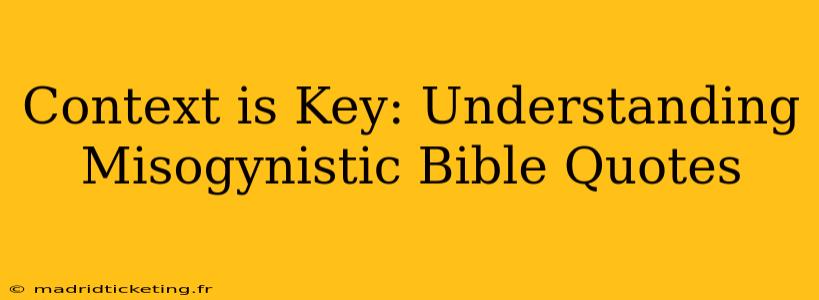The Bible, a cornerstone of many faiths, contains verses often cited as justification for misogynistic views. However, interpreting these passages requires careful consideration of historical context, cultural nuances, and the evolution of theological understanding. Simply pulling verses out of context risks perpetuating harmful interpretations and ignoring the broader message of love, equality, and justice that runs throughout scripture. This article aims to explore some frequently cited "misogynistic" quotes, providing the necessary context for a more nuanced and informed understanding.
Are there really misogynistic verses in the Bible?
This question itself highlights the complexity of the issue. The existence of verses that appear to promote gender inequality is undeniable. However, labeling the entire Bible as "misogynistic" is an oversimplification and ignores the evolving interpretations throughout history and across different theological perspectives. The key lies in understanding why certain passages were written and how they've been misinterpreted over time.
How should we interpret seemingly misogynistic Bible verses?
Understanding the historical and cultural context is paramount. Many passages reflect the patriarchal societies in which they were written. Ancient Near Eastern cultures, for example, often held vastly different views on gender roles than are prevalent today. To apply these ancient societal norms directly to contemporary life without critical analysis is a misreading of the text.
Furthermore, we must examine the literary genres. The Bible isn't a single, monolithic document. It comprises various literary forms, including poetry, law, history, prophecy, and parables. Each genre must be interpreted within its specific literary framework. What might appear to be a literal command in one genre might be a poetic metaphor or a historical account in another.
What are some examples of frequently misinterpreted verses?
Several passages are frequently cited as examples of misogynistic teachings. Let's examine some of these with their context in mind:
1 Timothy 2:11-15: Women should learn in quietness and full submission.
This passage is often interpreted as a blanket prohibition against women in leadership roles. However, understanding the historical context reveals that Paul, the purported author, was addressing specific issues within a particular church community. The "quietness and submission" may have referred to the disorderly behavior of some women in the early church, rather than a universal decree. Moreover, many female leaders throughout Christian history have profoundly impacted the faith. The passage shouldn't be used to restrict women's participation in ministry or leadership today.
Ephesians 5:22-24: Wives, submit to your husbands.
This verse, like 1 Timothy, is often taken out of its context. The concept of "submission" within this passage needs careful consideration. It isn't about subjugation or inequality, but rather a call for mutual respect and understanding within the marital relationship. This interpretation must align with the broader message of love, sacrifice, and mutual support found throughout the Bible. The passage should not be used to condone abuse or unequal power dynamics.
Genesis 3:16: To the woman he said, "I will make your pains in childbearing very severe; with painful labor you will give birth to children."
This verse is sometimes interpreted as a divine curse on women, imposing suffering upon them. However, a broader reading recognizes this as part of the narrative of the fall of humanity, where sin introduced suffering and hardship into the world. Focusing solely on the suffering of women in childbirth neglects the broader context of suffering for all of humanity due to sin.
How can we reconcile these passages with modern understandings of gender equality?
Reconciling seemingly conflicting passages with modern understandings of gender equality requires critical analysis and an honest grappling with the limitations of interpreting ancient texts in a contemporary context. We must prioritize the overarching themes of love, justice, and equality that permeate the Bible. Recognizing the historical and cultural factors influencing the text allows for a more nuanced understanding, moving beyond simplistic interpretations that perpetuate harmful biases. The message of the Bible is fundamentally one of inclusion and empowerment, even if some passages may initially seem to contradict this. It’s through thoughtful study and critical engagement that we can find a richer, more inclusive understanding of its teachings.
Conclusion
Interpreting the Bible requires careful consideration of its historical, cultural, and literary contexts. Attributing misogynistic intentions to the entire text is an oversimplification. While some verses might appear to promote gender inequality, a more nuanced understanding reveals that these passages frequently reflect the limitations of their time and should not be used to justify modern-day discrimination. A responsible and informed approach to biblical interpretation acknowledges these historical contexts and prioritizes the overarching messages of love, justice, and equality found throughout the scripture.

